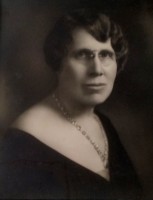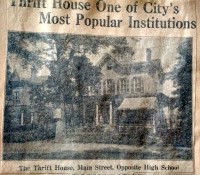Celebrating the 100-Year History of the Woman’s Club of White Plains Part 1 – Origins and Early Days, 1910’s and 1920’s

By Colleen Fay – Long before the Woman’s Club of White Plains was incorporated, there was a group of women called the Fortnightly Literary Club, which was formed in 1904. There were originally 15 members with membership capped at 30 but, as its popularity grew, membership increased. These women held meetings to discuss literature, drama, art, and current issues. In 1911 the group split into two organizations the New Century Club and the Woman’s Club, which had a major focus on community and philanthropy.
This original group was quite influential in the community. One of its original members, Mrs. Harriett Griffin, was the first woman elected to public office in White Plains as a member of the school board (at a time when women were not even allowed to vote). The women also organized annual clean-up days. Unsightly signs were removed and vacant lots cleaned. Signs were posted on various lots – “Do Not Dump Here by Order of the Woman’s Club.” The club was quite proud of their accomplishments and one time commandeered a local horse-drawn dump wagon, dressed up in “costumes” and wielding brooms rode down Main Street in a “spectacular parade.”

The two groups rejoined in 1916 calling themselves the Contemporary Club, consisting of 400 members. There were a number of sections in this newly combined club reflecting the varied interest of its members – Drama, Civic, Philanthropy, History, Travel, and Home Economics. At various times, the club met in the Farley building at 52 Orawaupum Street, the Grace Church Parish House and the Presbyterian Church. One of their earliest goals was to raise money for a new clubhouse. In 1917, the first Annual Dinner was held to raise money for the building fund.
With the onset of World War I, the Contemporary Club refocused its efforts and became involved in the war effort. The Spring Luncheon was renamed the Patriotic Tea and raised $110 for the Red Cross. Club members were involved in many war related activities: a meal canteen, the four-minute speakers, War Service Corps, a very active Red Cross section, adoption of French war orphans. Mrs. Belle Knight, the first president of the Club, headed up the War Stamp Committee that raised $17,000. In today’s dollars, that would be almost $400, 000. Mrs. Louisa Lockwood, another charter member of the Contemporary Club, was involved in the Canning Kitchen at Tod Market. Over 50,000 jars of vegetables, jams and jellies were produced and sent to various domestic as well as international hospitals. After the war, she wrote a book on White Plains during WWI. Finally, on May 30, 1919, the Club planted trees at the Armory in memory of those killed during the war.
Following the war, the Club continued its philanthropic and community efforts as well as its interest in current affairs. Presentations on a wide variety of political and social topics, some rather controversial, were sponsored at the club. The Thrift Shop was opened in 1921. Originally the shop sold clothing and furniture. The shop was one of the major supporters of philanthropy in the early days and to this day, it continues to help lower income families with clothing and other essentials.

Several new projects were started. In 1921 the Community Girls Works was founded and sponsored social programs for women and girls. They applied to the YMCA for use of its building and one day a week was granted. Classes in swimming, “weight normalizing,” rhythmic dancing, clogging, apparatus work and bowling were held and various girls club also met there. The program was so popular that additional meeting space was rented at 124 Main Street. The group was rapidly outgrowing its facilities and in February 1929 an application was submitted for a local branch of the YWCA to be opened in White Plains. By April 1929, this became a reality.
Club Dial, the monthly magazine of the organization, was first published in 1928 and contained articles on current affairs as well as more mundane topics as decorating, parenting and cooking. Some of the original advertisers (which were quite numerous) were Hecht Hardware, Schwackhammer Coal, the Peddie School in NJ (with a list of Contemporary Club women who had sons there), Wallauer Paint and Lyon and Hartnett Funeral home. The cost was 15 cents and was circulated as far away as Alaska, Europe and Africa. Proceeds from the sale were used for philanthropic efforts.
The Club also resumed efforts to establish a new clubhouse. In 1922 a lot was acquired on Martine Avenue for $8,000 and sold several years later for five times the original purchase price. White Plains, at this time, was undergoing rapid growth and real estate prices were skyrocketing. In 1927 club members voted to purchase a larger property on Hartsdale Avenue near the site of the new high school (now the middle school) and architectural plans were drawn up.
Again, the increasing value of real estate led the Club to sell this property for twice its original value.
As the decade drew to a close, the stock market crash of October 1929 led to the worst depression in US history.
Part 2 of this series will explain how the Woman’s Club survived and then thrived.

Examiner Media – Keeping you informed with professionally-reported local news, features, and sports coverage.
